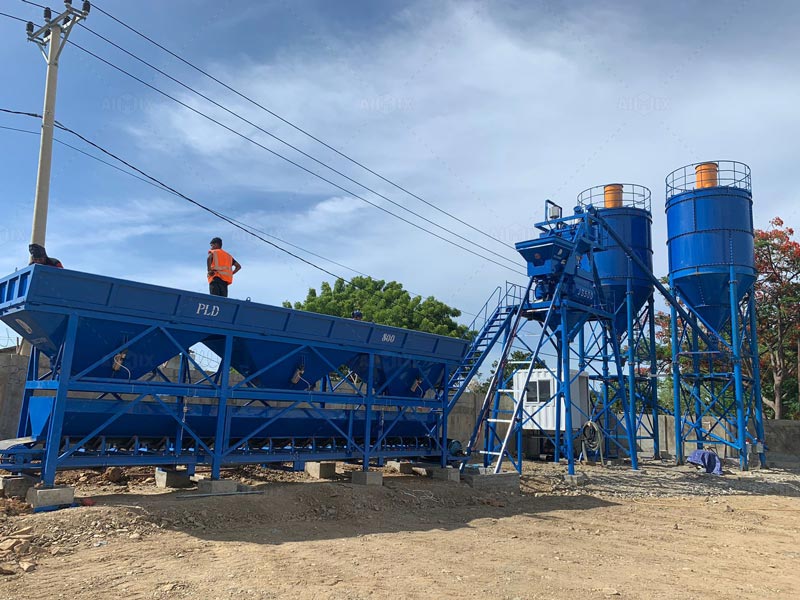Small Concrete Plants vs Large Plants: Which One is More Suitable for Your Project Needs?
When it comes to selecting the right concrete plant for a construction project, contractors often face the choice between small concrete plants and large-scale plants. Both types offer unique advantages depending on the project requirements, space constraints, and budget. Understanding the key differences between small and large concrete plants will help you make an informed decision, ensuring that the plant you choose will meet your production needs efficiently and cost-effectively.
This blog post explores the advantages and limitations of small concrete plants(planta de concreto pequeña) and large plants, helping you determine which one is the best fit for your project.
Contents |
[edit] Key Differences Between Small and Large Concrete Plants
Concrete plants vary in size and capacity, with small concrete plants typically being more compact and designed for smaller projects, while large plants are built for large-scale operations. Understanding the benefits and drawbacks of each can guide your decision-making process.
[edit] 1. Production Capacity and Efficiency
One of the main differences between small concrete plants and large plants is their production capacity. Large plants are capable of producing a high volume of concrete in a short amount of time, making them ideal for large-scale construction projects such as highways, skyscrapers, and industrial buildings. These plants often come with multiple mixing units and sophisticated batching systems to meet the demands of high-volume production.
On the other hand, small concrete plants(planta de hormigon Perú) are designed for more modest production needs. They typically have a smaller capacity, making them better suited for smaller projects like residential buildings, road repairs, or small commercial constructions. While their production rate may be lower than that of large plants, small concrete plants can still deliver high-quality concrete efficiently for projects with more manageable requirements.
[edit] 2. Space and Mobility
The space requirements for a concrete plant can significantly impact your decision. Large concrete plants require a considerable amount of space, as they need to accommodate not only the batching system but also storage silos, conveyors, and other machinery. This means that large plants are often installed in permanent locations, which may limit their mobility.
In contrast, small concrete plants are compact and can be easily installed in tight spaces. They are also more portable, allowing contractors to move them between different job sites as needed. This flexibility makes small concrete plants a great option for contractors working on multiple projects in varying locations, especially when dealing with limited space on-site.
[edit] 3. Cost Considerations
The cost of purchasing and operating a concrete plant is another important factor to consider. Large concrete plants come with a higher initial investment due to their advanced equipment, larger size, and greater production capabilities. These plants are best suited for projects that require consistent, high-volume concrete production. While the price tag may be steep, the high efficiency and large-scale production capacity make them a worthwhile investment for major construction operations.
In comparison, small concrete plants are more affordable both in terms of initial purchase price and operational costs. The lower cost makes them accessible to contractors working on smaller projects or those with limited budgets. Additionally, small concrete plants typically have lower maintenance and energy costs, which further enhances their cost-effectiveness for smaller-scale operations.
File:Planta de Concreto Seco Pequea para Proyectos Residenciales.jpg
[edit] Which Concrete Plant Is Right for Your Project?
[edit] 1. Consider the Scale of Your Project
When deciding between a small concrete plant and a large plant, one of the most important factors to consider is the scale of your project. If you're working on a large construction site with high concrete demands, such as a highway, industrial facility, or commercial complex, a large concrete plant will provide the necessary output to keep up with the project’s timeline and production goals.
However, for smaller projects such as residential buildings, local road repairs, or small commercial projects, a small concrete plant will likely be more than sufficient. The ability to produce concrete locally and on-demand without the need for large quantities of material ensures that the plant(planta de hormigon movil) remains efficient and cost-effective for projects with lower concrete volume requirements.
[edit] 2. Evaluate Your Budget and Long-Term Needs
Budget plays a crucial role in selecting the appropriate concrete plant. If you are working on a one-off or short-term project, investing in a large plant may not be financially feasible. A small concrete plant offers a more economical solution for contractors on a budget, while still providing high-quality concrete production.
On the other hand, if you’re handling multiple large projects or planning long-term operations with high concrete demands, a large concrete plant can justify the higher initial investment. Over time, the larger plant’s production capacity and efficiency can lead to reduced costs and improved profitability.
[edit] 3. Assess Site Conditions and Mobility Requirements
The physical conditions of the construction site should also influence your decision. Large concrete plants require substantial space and a permanent installation, making them more suitable for large construction sites with ample room for the plant’s infrastructure. If your project site is constrained in terms of space or needs flexibility, a small concrete plant would be the better choice. These plants are designed to operate efficiently in smaller, more confined areas and can be relocated easily between job sites.
If your projects involve multiple sites or the need for rapid deployment, a portable small concrete plant can offer increased mobility, allowing you to take it wherever it is needed. For example, projects in remote or difficult-to-access areas benefit from the convenience of small concrete plants that don’t require extensive setup or installation.
[edit] Conclusion
Choosing between a small concrete plant and a large concrete plant comes down to the specific needs of your project. For large-scale operations with high concrete demands, a large concrete plant will provide the necessary production capacity and efficiency. However, for smaller, more flexible projects, a small concrete plant offers an affordable, space-saving, and portable solution that still delivers high-quality concrete.
By carefully evaluating your project’s size, budget, and location requirements, you can make an informed decision that ensures optimal performance and cost-effectiveness. Whether you need a large, high-capacity plant for a major construction project or a compact, portable solution for smaller builds, the right concrete plant will help you achieve your project goals efficiently and economically.
Featured articles and news
Design and construction industry podcasts
Professional development, practice, the pandemic, platforms and podcasts. Have we missed anything?
C20 Society; Buildings at Risk List 2025
10 more buildings published with updates on the past decade of buildings featured.
Boiler Upgrade Scheme and certifications consultation
Summary of government consultation, closing 11 June 2025.
Deputy editor of AT, Tim Fraser, discusses the newly formed society with its current chair, Chris Halligan MCIAT.
Barratt Lo-E passivhaus standard homes planned enmasse
With an initial 728 Lo-E homes across two sites and many more planned for the future.
Government urged to uphold Warm Homes commitment
ECA and industry bodies write to Government concerning its 13.2 billion Warm Homes manifesto commitment.
From project managers to rising stars, sustainability pioneers and more.
Places of Worship in Britain and Ireland, 1929-1990. Book review.
The emancipation of women in art.
Call for independent National Grenfell oversight mechanism
MHCLG share findings of Building Safety Inquiry in letter to Secretary of State and Minister for Building Safety.
The Architectural Technology Awards
AT Awards now open for this the sixth decade of CIAT.
50th Golden anniversary ECA Edmundson awards
Deadline for submissions Friday 30 May 2025.
The benefits of precast, off-site foundation systems
Top ten benefits of this notable innovation.
Encouraging individuals to take action saving water at home, work, and in their communities.
Takes a community to support mental health and wellbeing
The why of becoming a Mental Health Instructor explained.
Mental health awareness week 13-18 May
The theme is communities, they can provide a sense of belonging, safety, support in hard times, and a sense purpose.
Mental health support on the rise but workers still struggling
CIOB Understanding Mental Health in the Built Environment 2025 shows.
Design and construction material libraries
Material, sample, product or detail libraries a key component of any architectural design practice.

























